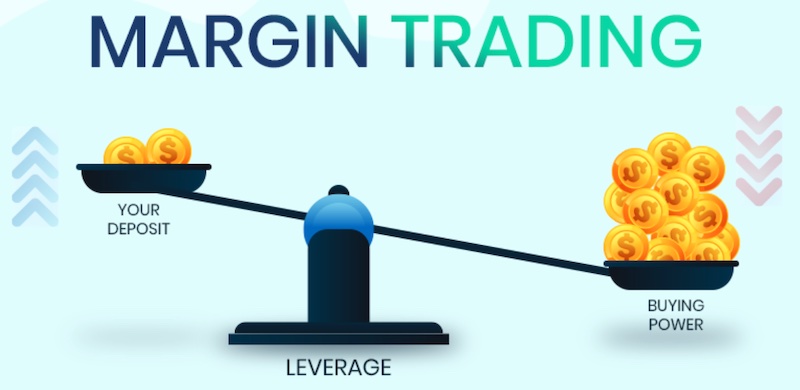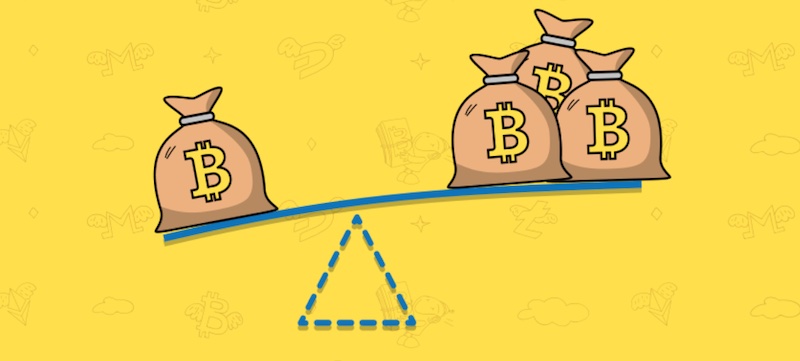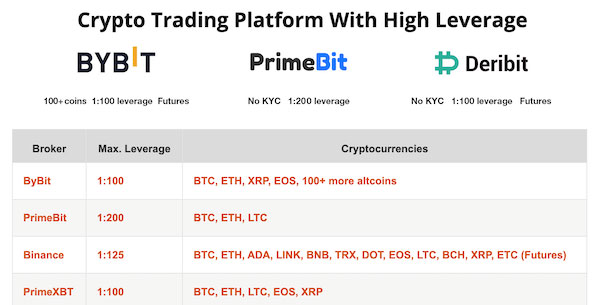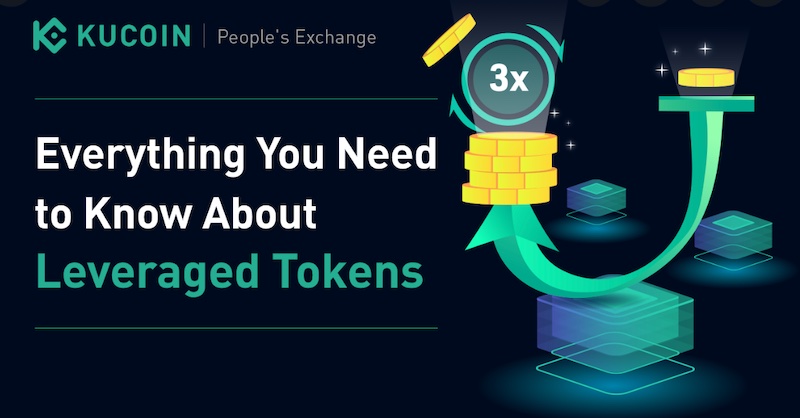The amount of leverage in crypto depicted in ratios looks like this: 5x represents a 1:5 ratio, and 20x represents 1:20. So, the ratio spells out how a trader's capital is multiplied.
This article will explore how to use leverage in crypto and some of the exchanges that offer it. To begin, let's look at some real-life trading examples.
What is Crypto Leverage Trading? - Examples
Let's say a trader has $100 in their account. But they're super confident that the price of Bitcoin is going to rise soon. The problem is they only have $100 to back their prediction. So, to maximize profits, they could open a position with 10x leverage upping their buying power to $1,000. The leverage ratio on this trade would be 1:10 ($100 x 10 = $1,000).
The good news for crypto traders is that they can leverage their positions differently. Margin trading and futures contracts come from traditional finance, but leveraged tokens are native to the "cryptoverse."

Are you new to crypto? Take the Crypto for Beginners course at Moralis Academy and quickly get up to speed!
What is Crypto Leverage Trading? How it Works
To figure out how to use crypto leverage when trading, you must first know that users must deposit funds (collateral) into their margin account.
For example, a trader wants to put $1,000 on Ethereum (ETH). But they only have $100. In this case, they would need to apply 10x leverage. The margin requirement of a 1:10 ratio would be 1/10 of $1,000, or $100. So, the trader could use their $100 as collateral to start.
Along with the initial margin deposit requirement, the trader must maintain a margin threshold, known as the "maintenance margin." So if the market price moves against the position and drives the margin lower than the threshold, the trader must add more funds to their account to avoid liquidation. Furthermore, "liquidation" means that the exchange takes possession of the trader's collateral.
So, what is crypto leverage trading? In short, it's a way for traders to maximize their returns by using other people's money.
As the war continues in Ukraine, find out how ordinary citizens are surviving and have become one of the largest adopters of crypto in our "Ukraine and Cryptocurrency" article.
How to Use Leverage in Crypto - Going Long
Crypto traders can use leverage to go long or short. If the investor expects a cryptocurrency's price to rise, he will open a long position (buy). If another trader predicts that the price will drop, she will take a short position (sell).

The above scenario demonstrates standard trading. However, when applying leverage, the trader can borrow on margin.
If a trader goes long on BTC for $10,000 with 10x leverage, he only needs to put $1,000 as collateral. If Bitcoin's price jumps 20%, the trader makes a $2,000 profit. That's a much better deal than only using his capital of $1,000. He would have only made a $200 profit without borrowing on margin.
On the flip side, if Bitcoin's price drops 20%, the trader would be down $2,000. So, understand that the 10x leverage works both ways. In this case, since the collateral requirement was only $1,000, the 20% BTC drop would cause the position to get liquidated before the 20% swing is completed. Thus a 10% drop in price would trigger a liquidation. (10% x $10,000 = $1,000).
However, different exchanges employ different liquidation values. Moreover, they will send the trader a "margin call" to warn that the account value has dropped below the maintenance margin. Margin calls give the trader a chance to add more funds to their account to avoid liquidation. If you're studying how to use leverage in crypto, don't forget to learn about margin calls.
How to Use Leverage in Crypto - Going Short
Let's flip the scenario to the short side, where a trader wants to open a $10,000 short position with 10x leverage. The collateral required is the same as the long position, $1,000.
So, the trader sells $10,000 worth of BTC, and the price drops 20%. Now the short seller can buy back the same amount of BTC for only $8,000. In this case, the short seller makes a $2,000 profit. On the other hand, if Bitcoin's price rises 20%, the short seller would need to add more funds to their account to avoid liquidation.
Note: None of these examples take margin trading fees into account.

More importantly, before you can successfully long or short the crypto markets with or without leverage, you need to predict future price direction. Take the Master Technical Analysis course at Moralis Academy to learn how.
Why Use Leverage to Trade Crypto?
If you've ever wondered, "what is crypto leverage trading?", then you need to understand that traders use leverage to build their position size and maximize profits. Also, when determining how to use leverage in crypto, traders must ask, "why use it?". Besides maximizing profits, another reason to margin trade is to enhance liquidity.
For example, a trader could take $1,000 and put it on a single trade with 1x leverage. Or, she could take a 4x leveraged position with the same collateral of $1,000. Otherwise, the trader would need to put $4,000 of her money into the trade. By trading on margin, she only needs to tie up $1,000, leaving an extra $3,000 to put to work elsewhere. As a result, a trader can make a smaller amount of money, go a long way.
Have you ever noticed that people are more interested in learning what crypto leverage trading is during bull markets? But in the present conditions, one also needs to learn how to survive a bear market. Furthermore, blockchain gaming is one sector that’s growing in popularity despite the recent downturn in the crypto market. As such, be sure to check out our blog to find out about the top gaming tokens!
Managing Risks with Leveraged Trading
Leveraged crypto trading requires less capital to start but comes with liquidation risk. Thus, if a trader gets their leverage ratio too high, an incremental price change can lead to significant losses.

So, the more leveraged a trader becomes, the more volatility will affect them. Going with lower leverage offers a trader more margin of error on price swings. Hence, some crypto exchanges put ceilings on how much leverage beginners can use.
To manage risks, traders can use "stop-loss" and "take-profit" orders. These kinds of trades can help minimize risk. A stop-loss order automatically closes a position at a specific price point. This feature saves a trader when the market whips against them.
On the other hand, take-profit orders do the opposite. These orders close out a position when profits reach a certain point. Take-profit orders lock in earnings at a specific price before the market can change direction.
You've probably realized that there are two sides to leverage trading. There is the potential for multiplied profits but also excessive losses. Moreover, notice that leverage increases both exponentially.
Margin Calls
It's hard to foresee a cryptocurrency's future price action correctly. Thus, when an asset's price quickly moves contrary to the prediction, the trader must act quickly. They risk liquidation if they don't deposit more collateral to their margin account.
When crypto prices whipsaw against a trader, the exchange will move quickly to cover itself. If the trader doesn't respond to a margin call by depositing more funds, they can get liquidated for the total amount of the margin loan.
To avoid getting liquidated, traders should only risk a manageable size of crypto (not more than they can afford to lose) and keep a "stop-loss" in place.
Pros and Cons of Margin Trading with Cryptocurrencies
Pros:
Volatile crypto markets mean more profits when a leveraged trader predicts correctly. Further, high-risk tolerance, good analytical skills, and competent stop-loss order placement can make leverage trading more profitable.
Cons:
However, greater price volatility means more losses for leverage traders who get the market wrong. Beginners can easily get liquidated, and experienced traders have to be willing to put in the time to babysit their trades. So, when looking at how to use leverage in crypto, also look at the “cons.”
Crypto Exchanges with Leverage

When discussing the "what is crypto leverage trading?" question, we need to look at which crypto margin platforms offer the highest amount of leverage. Below are some to choose from:
1. Bybit
Leverage: 1:100
Coins: ETH, BTC, XRP, and various altcoins.
2. PrimeBit (Has the Highest Leverage)
Leverage: 1:200
Coins: ETH, BTC, LTC.
3. Binance
Leverage: 1:125
Coins: ADA, BNB, BTC, ETH, DOT, XRP, and many others.
4. BitMEX
Leverage: 1:100
Coins: BTC, ETH, LTC.
5. PrimeXBT
Leverage: 1:100
Coins: BTC, ETH, XRP, and others.
Decentralized autonomous organizations are becoming the "go-to" way to implement community governance for crypto projects. Learn how to create a DAO from one of our recent blog articles at Moralis Academy.
Crypto Exchanges with Leverage - Using Leveraged Tokens
When determining how to use leverage in crypto, traditional margin trading isn't the only way to go. Crypto offers another way, and that is "leveraged tokens."
For example, a 3x "long Ethereum token" (ETHBULL) triples the profits of an Ethereum investment. So if ETH's price grows by 10%, ETHBULL's value increases by 30%. On the flip side, it goes the opposite direction if ETH's price drops.
Leveraged tokens can also be risky, so it's best to learn more about them to avoid regrettable decisions later. Binance, KuCoin, and FTX are some of the crypto exchanges that offer them.

Leveraged Token Features (1 - 3)
1. Rebalancing
In the example above, ETHBULL offers three times the underlying asset. The token automatically rebalances to maintain the 3x target. If it makes money, it reinvests the profits. If it's losing, ETHBULL will sell some of its position. Leveraged tokens usually rebalance each day.
Binance's leveraged tokens work a little differently. Rather than using a specific target, they use a range typically between 1.25x to 4x the underlying asset's price.
2. Simplicity
Traditional margin trading can be complex and requires thorough babysitting. On the other hand, leveraged tokens are simple to use.
3. Zero Collateral
There are no collateral or margin requirements to use leveraged tokens, and liquidation risks are low due to rebalancing. Even if the token's value drops, it's programmed to sell some of its position.
So, when asking, "what is crypto leverage trading?", understand that leveraged tokens have to be part of that conversation. Now, let's take a look at some more features.

Leveraged Token Features (4 - 7)
4. Volatility Decay
However, leveraged tokens do come with risks, and "volatility decay" is the most prominent. It refers to the negative impact of volatility on the investment. The best way to explain how it works is with a real-life trading example.
If a trader buys $1,000 worth of ETH straight up and the price jumps 10%, the ETH is now worth $1,100. But suddenly, the price whipsaws and drops by 10%. $1,100 x 10% = 110. So, now the trader's ETH holdings are worth $990 (1,100 - 110).
Take the same scenario with a leveraged 3x BULLETH token. A 10% increase turns the $1,000 investment into a 30% gain or $1,300. The next day the price drops by 10%. The leveraged token turns that into a 30% loss. $1,300 x .30 = $390. The resulting value is $910 ($1,300 - $390).
The point is that volatility decay chips away at an investment at a higher rate than standard trades.
5. Not Readily Available
Many crypto exchanges don't offer leveraged tokens, so they can be hard to find, especially for US residents.
6. Additional Fees
There are extra fees associated with leveraged tokens. Binance, for instance, charges a daily management fee of 0.01%.
7. Short Term
Because of volatility decay and management fees, long-term "buy-and-hold" strategies don't work for leveraged tokens.

What is Crypto Leverage Trading? - Conclusion
Leverage allows traders to get started with lower initial capital investments. It also offers the potential to make higher profits. On the other hand, market volatility can cause quick liquidations, especially at the higher levels up to 100x leverage.
Good trading rules apply, but even more so with leveraged trading. Traders must always proceed with caution and never trade with more than they can afford to lose. Just remember, the higher the leverage, the higher the risk of liquidation.
Trading with leverage is a risky business. On the other hand, building decentralized applications (dapps) on Ethereum can be just as lucrative without all the risk. So, why not learn how to build dapps at Moralis Academy today?




